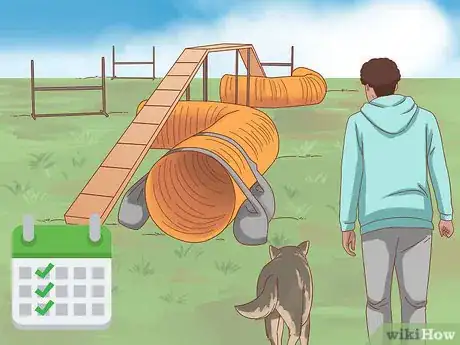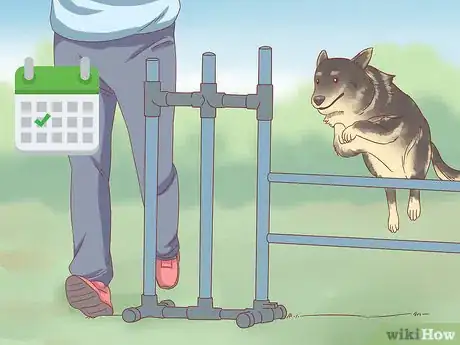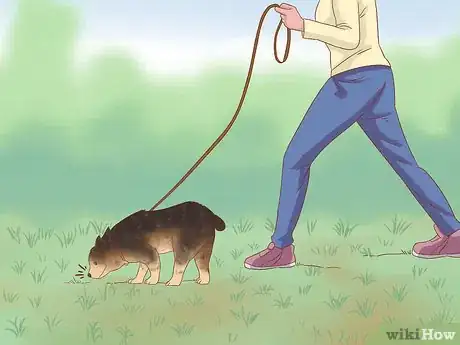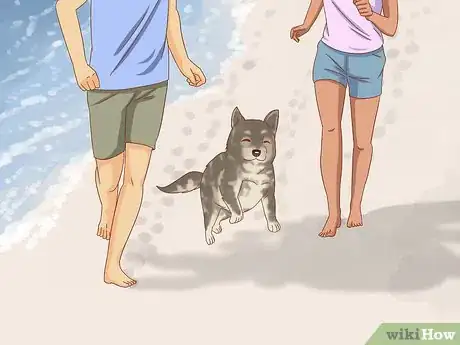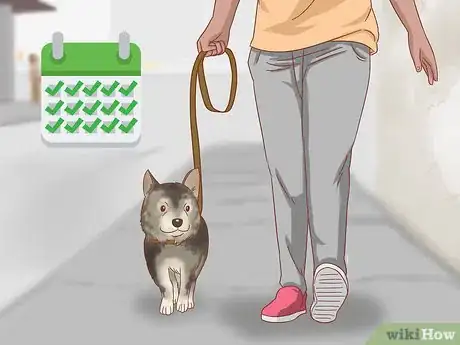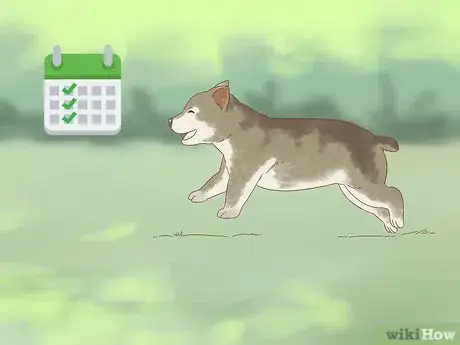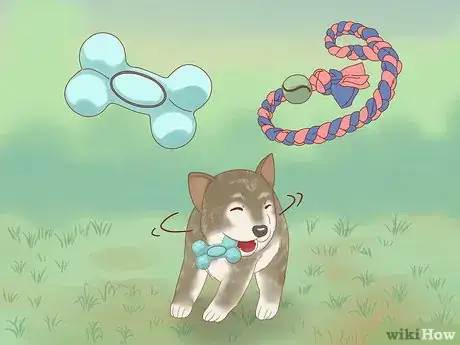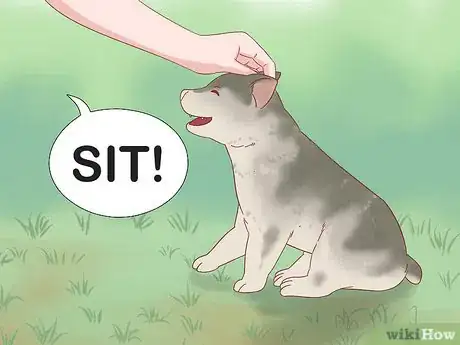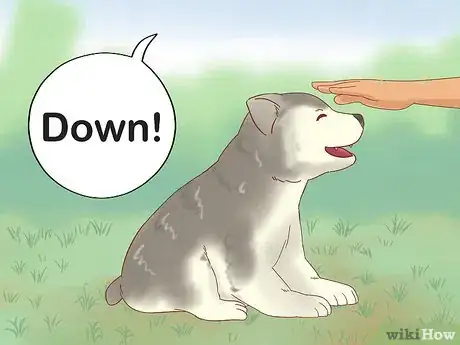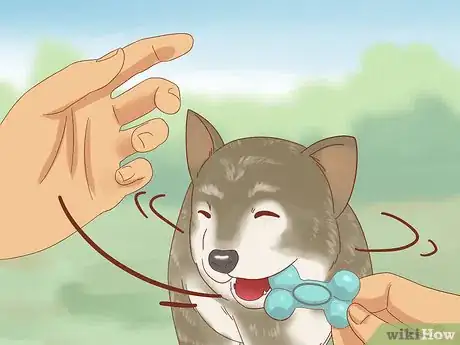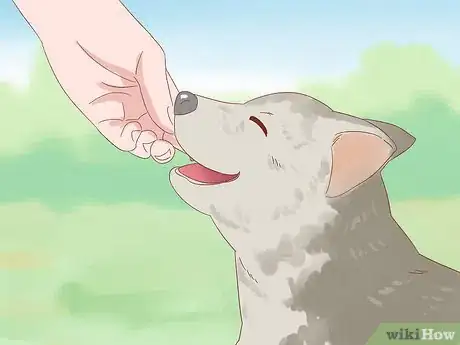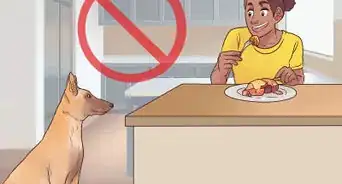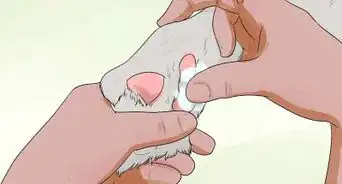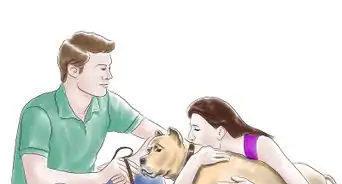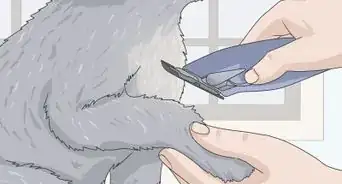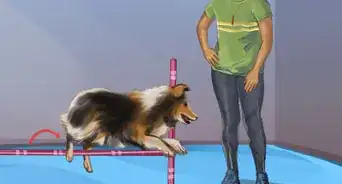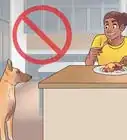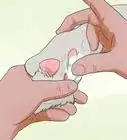This article was co-authored by Alexis Toriello. Alexis Toriello is a Certified Dog Behavior Consultant and the Founder and CEO of Zen Dog Training in New York. Her time working as a canine behavior specialist in various animal shelters has made her knowledgeable in assessing, rehabilitating, and training dogs. In addition to being an Associate Certified Dog Behavior Consultant (ACDBC), Alexis is a Certified Professional Dog Trainer - Knowledge Assessed (CPDT-KA) and a Master’s Degree Candidate in Animal Behavior and Conservation at Hunter College. She is certified by the American Red Cross in Canine First-Aid and CPR and has endorsements from numerous hospitals and clinics and the Washington Humane Society.
There are 12 references cited in this article, which can be found at the bottom of the page.
This article has been viewed 24,627 times.
If you have a Blue Heeler, you know it’s a dog with a lot of stamina. That energy combined with their intelligence means they need to be kept busy in ways that stimulate their body and mind. Agility courses, walks, toys, and games are great ways to energize Blue Heelers, while also bonding with them.
Steps
Trying Organized Activities
-
1Go to an agility course once a week to challenge your dog. Blue Heelers are a particularly intelligent breed of dog, and an agility course is a great way for them to use their smarts! An agility course will challenge your pup to be obedient.
- Agility courses can improve your dog’s behavior without having to go to a formal dog trainer. It will keep your pup from being bored and is sure to tucker him out![1]
- If you live near a park, see if they have an agility course. Otherwise, you can buy or design your own course.
-
2Participate in dog rallies once a month. Rally sports are a form of training that combines agility with obedience. Blue Heelers are already naturally agile and fast learners, so rallying is a perfect activity for them!
- Dogs are led by their handlers and participate in several different activities: commands, turns, jumps, spirals, and others.[2]
- Blue Heelers are active and competitive, so participating in sports will channel their drive while also providing them a job that keeps them busy.
Advertisement -
3Find a tracking course or competition to strengthen your pup's abilities. Dogs are naturally nosey, and Blue Heelers are no exception. Known for their herding abilities, this breed has no problem using its nose to track something, whether it be cattle, a toy, or its favorite human.[3]
- Tracking allows your pup to hone the abilities that come naturally to it.[4]
-
4Involve your pup in family activities whenever possible. Though Blue Heelers' herding nature makes them suitable as one-person dogs, they still like to be in a group. If you're planning on visiting family or friends or spending the day at the beach, take your pup with you. The more people your dog is around, the easier it is to use up its excess energy.[5]
- Encourage family members to engage with your pup. Come prepared with your Blue Heeler's favorite chew or puzzle toy and show your family how it likes to play.
- Blue Heelers like to "herd" family members when they want something, so be wary: if they try to bite or nip at someone, give them a chew toy or some food. Otherwise, your Heeler could harm a family member.
Keeping Your Dog Active on a Regular Basis
-
1Take your pup on walks daily. Nothing can curb your Blue Heeler's energy quite like a walk. Not only is this a great way for your dog to get some exercise, but your Blue Heeler can also become familiar with the neighborhood.
- Dogs can become afraid of sounds that may be all too common for you, such as cars or motorcycles, so it’s best to get them used to the sounds of its environment to eliminate any fears.[6]
- If you’re really looking to venture out and find a new walking area, try nature trails, beaches, or state parks.[7]
-
2Go to the park at least once daily. Blue Heelers need open spaces and can't stay cooped up in a house or apartment for long. With so much energy to burn, your pup could benefit from a romp at the park every day.
- Blue Heelers need time outside. If they're stuck in the house with nothing to do, they could break a thing or 2.
- It's important to allow your dog some off-leash time daily, but you will also need to ensure your dog will come back when you call. Be sure to teach them the "come" command so that you can get your dog to come back to you when it's time to leave.
-
3Provide your dog with a variety of toys. Blue Heelers tend to get bored easily, so you have to be picky when choosing a toy for your pup! They like toys that stimulate the mind best, so puzzle toys, chew toys, and tug toys work best.[8]
- Because of their high energy, Blue Heelers can be rough, so find a durable toy. It might be a bit more expensive, but you will save money in the long run because your Heeler won't easily destroy it.[9]
Training Your Dog
-
1Teach your Blue Heeler to sit. Start with the basics, and say your Blue Heeler's name, followed by "sit" in a higher, demanding tone. Don't forget to hold him and gently push down on him as he learns.[10]
- Don't expect your pup to get this down right away. Blue Heelers have a lot of energy, so it could take time to curb that enthusiasm. Be patient and practice with it. Working in 10-minute sessions multiple times a day can really help keep them busy.[11]
- Keep in mind that Blue Heelers' intelligence allow them to easily outsmart their owners.[12]
-
2Teach your pup how to stay down. Once your dog has learned how to sit, you can teach it the "down" command. With a treat in your hand, tell your pup to sit. Once it's done that, lay the treat down and say "down."
- If your Blue Heeler doesn't understand right away, guide him to the floor.
- Using some force to guide your Blue Heeler down will show it who is in charge. This breed's willfulness can sometimes make it difficult to know who's training who![13]
-
3Redirect your pup's tendency to nip at an early age. Blue Heelers are herding dogs by nature, so they habitually nip at people's heels and sometimes other animals. If your pup tries to bite at you, redirect its attention by moving your body part away and offer a treat or chew toy for it to bite instead.[14]
- Once your Blue Heeler understands basic commands like "sit" and "down," it will also understand your reprimanding when it nips.
- If you have children, make sure they are careful with your Blue Heeler while you are training him. You don't want them to get injured.[15]
-
4Reward your pup with treats. The best way to show your Blue Heeler it's doing the right thing is through rewards. Treats, pats, and praise will all work on this breed.
- Blue Heelers are smart enough to understand what they're doing wrong. This is what makes them easy to train, despite some stubbornness.
- Withholding treats and teaching them the word "no" will be helpful in preventing bad behavior.[16]
Expert Q&A
-
QuestionHow do I entertain a Blue Heeler puppy?
 Alexis TorielloAlexis Toriello is a Certified Dog Behavior Consultant and the Founder and CEO of Zen Dog Training in New York. Her time working as a canine behavior specialist in various animal shelters has made her knowledgeable in assessing, rehabilitating, and training dogs. In addition to being an Associate Certified Dog Behavior Consultant (ACDBC), Alexis is a Certified Professional Dog Trainer - Knowledge Assessed (CPDT-KA) and a Master’s Degree Candidate in Animal Behavior and Conservation at Hunter College. She is certified by the American Red Cross in Canine First-Aid and CPR and has endorsements from numerous hospitals and clinics and the Washington Humane Society.
Alexis TorielloAlexis Toriello is a Certified Dog Behavior Consultant and the Founder and CEO of Zen Dog Training in New York. Her time working as a canine behavior specialist in various animal shelters has made her knowledgeable in assessing, rehabilitating, and training dogs. In addition to being an Associate Certified Dog Behavior Consultant (ACDBC), Alexis is a Certified Professional Dog Trainer - Knowledge Assessed (CPDT-KA) and a Master’s Degree Candidate in Animal Behavior and Conservation at Hunter College. She is certified by the American Red Cross in Canine First-Aid and CPR and has endorsements from numerous hospitals and clinics and the Washington Humane Society.
Certified Dog Behavior Consultant Keep your puppy mentally stimulated by giving it some challenging puzzle toys with treats.
Keep your puppy mentally stimulated by giving it some challenging puzzle toys with treats. -
QuestionHow do you train a Blue Heeler puppy?
 Pippa Elliott, MRCVSDr. Elliott, BVMS, MRCVS is a veterinarian with over 30 years of experience in veterinary surgery and companion animal practice. She graduated from the University of Glasgow in 1987 with a degree in veterinary medicine and surgery. She has worked at the same animal clinic in her hometown for over 20 years.
Pippa Elliott, MRCVSDr. Elliott, BVMS, MRCVS is a veterinarian with over 30 years of experience in veterinary surgery and companion animal practice. She graduated from the University of Glasgow in 1987 with a degree in veterinary medicine and surgery. She has worked at the same animal clinic in her hometown for over 20 years.
Veterinarian Reward-based training methods are ideal. This encourages the dog to repeat desirable actions by giving them a reward. As intelligent dogs, Blue Heelers respond well to this method.
Reward-based training methods are ideal. This encourages the dog to repeat desirable actions by giving them a reward. As intelligent dogs, Blue Heelers respond well to this method. -
QuestionAre Blue Heelers protective?
 Pippa Elliott, MRCVSDr. Elliott, BVMS, MRCVS is a veterinarian with over 30 years of experience in veterinary surgery and companion animal practice. She graduated from the University of Glasgow in 1987 with a degree in veterinary medicine and surgery. She has worked at the same animal clinic in her hometown for over 20 years.
Pippa Elliott, MRCVSDr. Elliott, BVMS, MRCVS is a veterinarian with over 30 years of experience in veterinary surgery and companion animal practice. She graduated from the University of Glasgow in 1987 with a degree in veterinary medicine and surgery. She has worked at the same animal clinic in her hometown for over 20 years.
Veterinarian Blue Heelers are herding dogs and like to round things up. This does give them a sense of guardianship and makes them protective of things in their care. So yes, Blue Heelers are considered a protective dog, which can make them a good choice as pet and watchdog.
Blue Heelers are herding dogs and like to round things up. This does give them a sense of guardianship and makes them protective of things in their care. So yes, Blue Heelers are considered a protective dog, which can make them a good choice as pet and watchdog.
References
- ↑ http://3lostdogs.com/a-beginners-guide-to-dog-agility/
- ↑ https://tractive.com/blog/en/training-en/rally-obedience-dog-training
- ↑ https://www.akc.org/expert-advice/lifestyle/did-you-know/smart-hard-working-athletic-and-loyal-so-many-reason-to-love-the-australian/
- ↑ https://www.akc.org/sports/tracking/
- ↑ http://dogtime.com/dog-breeds/australian-cattle-dog#/slide/1
- ↑ https://www.foundanimals.org/10-truths-dog-walking/
- ↑ http://www.ctvisit.com/articles/great-places-hike-your-dog
- ↑ Alexis Toriello. Certified Dog Behavior Consultant. Expert Interview. 23 February 2021
- ↑ https://thehappypuppysite.com/best-toys-for-blue-heeler-dogs/
- ↑ https://dogappy.com/blue-heeler-training-tips
- ↑ Alexis Toriello. Certified Dog Behavior Consultant. Expert Interview. 23 February 2021
- ↑ https://www.akc.org/dog-breeds/australian-cattle-dog/
- ↑ https://dogappy.com/blue-heeler-training-tips
- ↑ https://www.cesarsway.com/dog-behavior/biting/nipping-nipping-in-the-bud
- ↑ https://dogappy.com/blue-heeler-training-tips
- ↑ https://dogappy.com/blue-heeler-training-tips
